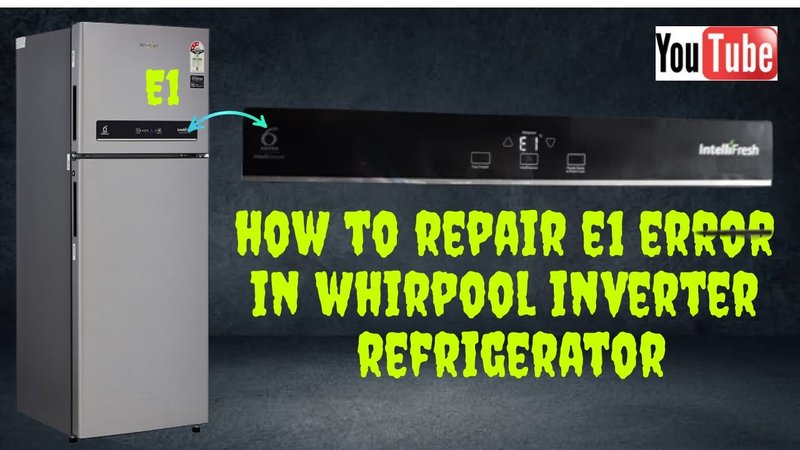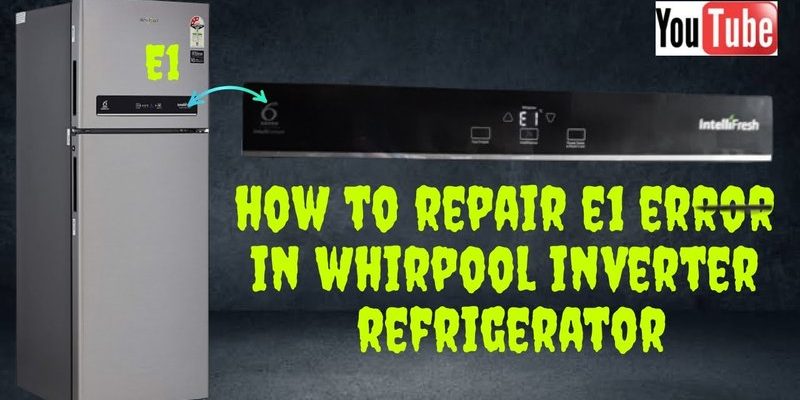
First off, seeing an error code pop up can be a bit like seeing the check engine light in your car. It’s a signal that something isn’t quite right, but it doesn’t always mean an immediate, drastic problem. In the case of the Whirlpool refrigerator, the E1 error code typically refers to an issue with the refrigerator’s temperature sensor. This component is crucial because it helps regulate the internal temperature, ensuring your food stays fresh. When it malfunctions, it’s like a faulty thermostat in your home—it doesn’t mean everything’s going to freeze over, but it does need attention.
Understanding Error Code E1
So, what’s this E1 code all about? In Whirlpool refrigerators, the E1 error code usually indicates a problem with the temperature sensor, also known as a thermistor. Think of the thermistor as the refrigerator’s “weather forecaster.” It measures the temperature inside the fridge and alerts the control board to make adjustments to the cooling cycle. If this sensor goes awry, your fridge might not be able to maintain the correct temperature, which could harm your food’s freshness.
You might be wondering why this happens. Well, just like any other component, sensors can wear out over time. They can also be affected by power surges or become disconnected. Imagine it like a delicate balance beam—if it tips too far to one side because of wear and tear or a power jolt, it sends the wrong signals. And when this happens, the refrigerator’s control system flags the issue with an E1 code.
Now, seeing this code doesn’t mean you should dive in and start unscrewing parts. While it might be tempting to play detective and fix things yourself, it’s often best left to the professionals unless you’re well-versed in appliance repair. Incorrect attempts to fix the issue could lead to further complications, similar to trying to repair your car engine without the right tools or know-how.
When Should You Call a Technician?
So, let’s get down to business: when should you actually call in a professional? The E1 code should prompt you to act, but it doesn’t have to cause panic. If you’ve tried the basic troubleshooting steps, such as unplugging the refrigerator for a few minutes to reset it, and the error persists, it’s time to call a technician. Think of this like rebooting your computer—it’s the first step we all take when something goes wrong, but it’s not always the fix.
Another scenario that warrants professional help is if you notice the temperature inside your refrigerator fluctuating wildly or not cooling at all. Your refrigerator is like a giant safe for your food, and if it’s not protecting your groceries properly, a technician can identify if the thermistor needs replacing or if another component is causing the issue.
Lastly, if other unusual symptoms accompany the E1 code—like erratic noises, unusual frost build-up, or a non-responsive control panel—it’s a strong indicator that professional intervention is necessary. These can be signs of more complex issues that extend beyond the temperature sensor itself.
Why A Technician Is Essential
Why exactly should you call a technician instead of trying to fix it yourself? First off, technicians have the right tools and experience to diagnose and remedy the issue efficiently. Imagine trying to navigate a maze without a map—that’s what DIY repairs can feel like without proper expertise. Plus, a technician can spot potential problems that might not yet trigger an error code, offering you peace of mind that everything’s running smoothly.
Technicians also have access to original parts if replacements are needed. Using the right components is key to ensuring that your fridge remains reliable without voiding warranties or causing additional issues. It’s a bit like putting the right type of fuel in your car to keep it running optimally.
Finally, consider the time and stress saved by having a professional handle the repair. They can often get things resolved faster than you could decipher what’s happening under the hood. After all, your time is valuable, and having a fridge full of spoiled food because of a delay wouldn’t be ideal.
Preventative Measures
Now that we know when to call a technician, let’s talk about how to prevent future issues. Regular maintenance is key—a little like feeding your pet or watering your plants. Ensuring your refrigerator coils are clean can go a long way. Dust and debris can cause your fridge to work harder, which in turn can lead to more wear and tear on components like the temperature sensor.
Secondly, keep an eye on your fridge’s performance. If you notice anything off before an error code appears—such as excessive frost or inconsistent cooling—don’t ignore it. These can be early warning signs that something isn’t right, giving you the chance to address problems before they escalate into an E1 error.
And consider routine check-ups with a technician as preventative medicine for your appliance. Just as you visit a doctor for a health check, having your refrigerator inspected can prevent small hiccups from turning into major headaches.
In conclusion, while an E1 error on your Whirlpool refrigerator might seem daunting, it’s often a manageable issue when approached correctly. By understanding what this code signifies, recognizing when to call in the pros, and following some simple preventative steps, you can keep your fridge running smoothly and your peace of mind intact.
